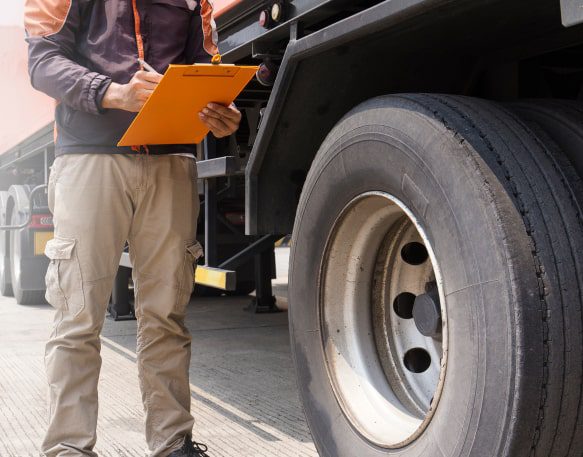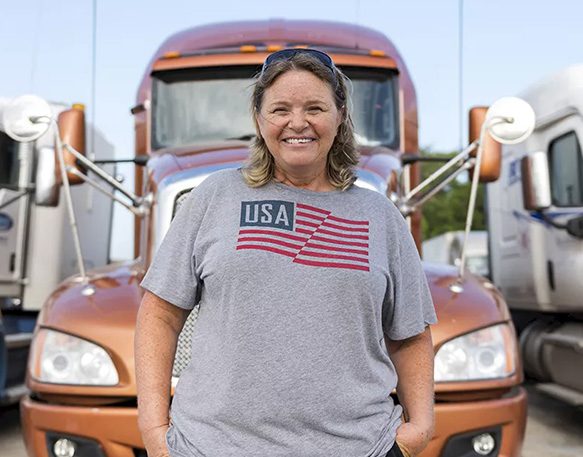But don’t think of a roadside inspection as a walk of shame. Instead, consider it an opportunity to demonstrate your compliance with the rules and your proactive care for your vehicle and for road safety.
What is a roadside inspection for truckers?
Many truckers wonder: How can you prepare for and pass roadside inspection? To answer that question, it’s important to start with definitions. A roadside inspection is a process conducted by Motor Carrier Safety Assistance Program (MCSAP) inspectors. These inspectors operate under the direction of the U.S. Department of Transportation (DOT) Federal Motor Carrier Safety Administration (FMCSA).
The roadside inspection can occur while you are stopped at a weigh station or after you’re pulled over on the highway. During it, you can expect a combination of conversation and direct questions from the inspector, who is trying to determine your level of compliance with DOT protocols.
No matter where the roadside inspection occurs it’s important to remember that these are normal and you shouldn’t be worried about experiencing one. DOT roadside inspections happen across the U.S. every day of the week and everyone who operates a large vehicle experiences them from time to time. The important thing is to remain calm and remember that the goal of the inspection is to make the roads safer for everyone.
So how can you prepare for and pass roadside inspection? To answer that question, we first need to dive deeper into different levels of DOT roadside inspections.
How many different levels of roadside inspections are there?
Every roadside inspection is different, but there are eight levels overall that they will all fall into. As described by the road safety nonprofit Commercial Vehicle Safety Alliance, the inspection levels are:
- Level I: North American Standard Inspection. During this inspection, expect a thorough review of factors including your driver’s license, your record of duty status and hours of service. The inspector will also perform a complete review of the vehicle from stem to stern, going under the hood and under the chassis.
- Level II: Walk-Around Inspection. Although less extensive than a Level I roadside inspection, a Level II inspection still reviews many of the same items included in Level I. The difference is that, in this case, the inspector wants to check out details about you and your truck that are readily visible without needing to actually get underneath the vehicle.
- Level III: Driver Credential Inspection. This roadside inspection is all about understanding you as a truck driver. The inspector will ask to view papers such as your license, record of duty, and hours of service. They’ll also ask to see your vehicle inspection reports.
- Level IV: Special Inspections. From time to time, the government and inspectors want to study a specific trend or topic across the trucking community. When that occurs, they will implement Level IV DOT roadside inspections that are targeted to help authorities answer their questions on that subject.
- Level V: Vehicle-Only Inspection. The Level V roadside inspection is the opposite of a Level III inspection. It involves the inspector taking a look at your vehicle in much the same way as in a Level I inspection, investing multiple vehicle components that may involve getting under the vehicle. The difference is that the driver does not need to be present at the scene.
- Level VI: Transuranic Waste and Highway Route Controlled Quantities of Radioactive Material Inspection. The Level VI roadside inspection is only applicable to truckers who carry specific types of radioactive materials. It’s designed to ensure they are operating in a safe way that won’t harm those around them. Because there are specific requirements for transporting hazardous materials, this DOT roadside inspection falls under a separate level.
- Level VII: Other Vehicle-Specific Inspections. Some vehicles, such as school buses and taxis, require additional review beyond what’s included in the earlier levels. This category covers those vehicle-specific roadside inspections.
- Level VIII: North American Standard Electronic Inspection. Unlike every other type of roadside inspection, Level VIII inspections don’t require you to pull over. That’s because the inspections are conducted electronically while you’re driving, capturing several data points of interest to inspectors including GPS coordinates, record of duty status, hours of service compliance, USDOT number, and more.
While it’s possible that a couple of these DOT roadside inspection levels don’t apply to you, it’s still useful to understand the different types of inspections occurring on the road so you can stay aware of the inspection landscape.
Steps to follow during a roadside inspection
During DOT roadside inspections, follow these general guidelines to help ensure a positive outcome for you and your inspector:
- Stay in your truck and remain friendly. In the past, inspectors expected carriers to step out of their vehicle and approach them. That thinking has shifted and it’s generally considered good form to remain in your vehicle when approached by an inspector. This gives them the chance to look over your vehicle before starting a conversation. When they approach, open your door, say hello and ask how you can help. Your inspector will tell you if they need you to step out of the cab.
- Keep your truck cab clean. Unkept cabs can trigger greater scrutiny. Keep your documents in a single place. Pick up and throw away trash when you stop, or keep a small trash can or bag on hand. Never carry drugs or alcohol. These basic principles can keep your inspection productive and friendly.
- Maintain good records. An important part of inspection is a review of your paperwork. You can lower your stress by reviewing the kinds of documents inspectors want to see beforehand. Then, be sure to store those documents in an easy-to-access place in your cab. Creating a DOT roadside inspection checklist for your paperwork can be a great resource to help you feel confident for your next inspection.
- Be honest in your responses. Don’t try to hide any inconvenient truths. Inspectors who find you in violation of code can render you out-of-service. This could cost you money, disrupt your schedule, and risk future career opportunities as a carrier. Answer inspector questions honestly and thoroughly and offer to clarify any details that they may need.
- Get regular maintenance on your truck. Many of the inspection levels include a detailed review of the components that keep your truck moving down the road and properly storing its freight. Some truckers make the mistake of painting over cracks or other structural flaws that could pose a safety risk. Don’t put yourself in this position. Get routine maintenance, fix problems before they threaten your next load, and listen to inspector feedback to ensure you know what it will take to remain compliant.
What are some common problems found in a roadside inspection?
There are a number of common problems found in roadside inspections. Check out this DOT roadside inspection checklist of common problems you should try to avoid:
- Unacceptable driver behavior. It’s important that you always behave politely and appropriately during a roadside inspection. Stay in your vehicle until you’re invited to exit and be sure to always respond calmly and patiently while the inspection occurs.
- Dirty cab. When the inside of your truck cab is a mess, it sends a bad message to inspectors. They might even question whether you’re intentionally hiding something. How can you prepare for and pass roadside inspection? Focus on cleanliness in the cab to send a good message from the outset.
- Confusing or missing records. Carriers that have gaps in their records or are unable to produce requested paperwork can set themselves up for hours off the road when they could be driving. Keep documents together and know what inspectors want you to have on hand so you can pass through inspections quickly and without any added stress or frustration.
- Dishonest or evasive answers. Question-and-answer sessions are a normal part of most inspections. These can seem intimidating, especially since inspectors might ask many questions — potentially even a few trick questions — to make sure you’re telling the whole truth and nothing but the truth. Always give clear and complete answers, even if you get the same question several times, and remain calm and polite. Remember, an inspector’s job is to keep you and those around you safe. Give them the benefit of the doubt and remain positive and truthful in your responses.
- Broken or damaged gear on your vehicle. Safety depends on having a well-maintained truck. The best way to prevent issues on the road is by conducting a thorough inspection yourself before each trip. If your vehicle is overdue for maintenance or could risk someone’s well-being, you can be sure an inspector will spot it and ask questions. If the issues present a potential safety hazard, you might need to make repairs immediately before you can return to service, even if you’re almost at your destination. While regular checkups may seem like they waste time that could be better spent on the road, they will save you significant time — and money — in the long-run.
How can I prepare before a roadside inspection happens?
There are several steps you can take to prepare for a roadside inspection to reduce stress, improve safety, and ensure you can get back on the road as quickly as possible.
First, remember that roadside inspections are a normal part of trucking and that just because you get one, that doesn’t mean there’s anything wrong with your vehicle. View it as a great opportunity to demonstrate your compliance to a safety authority.
Second, learn more about what happens during DOT roadside inspections. Although an inspection might initially come as a surprise, these are routine actions that aren’t designed to single you out as a driver. They are conducted regularly to keep you and other drivers safe and compliant with the law and they tend to follow the same format. The best way to ace one is to know what to expect and prepare for it. In addition to this article, you can check out the FMSCA website for more information.
Third, make sure you’re staying compliant and meeting DOT and FMSCA requirements each time you get on the road. That means performing your own inspections before each trip, ensuring your freight is tied down correctly, and planning your hours correctly to not exceed legal limits.
Finally, stay calm! Roadside inspections are a regular part of the job for carriers and owner-operators, so if you see an inspector coming toward you, stay calm and answer all their questions truthfully so you can get back on the road fast.
How can I make sure I’m following the rules to pass a roadside inspection?
Once you’re familiar with the basics of roadside inspections, it’s a good idea to talk with other truckers who have been through the inspection process. Ask specific questions that can help you learn. What questions did their inspectors ask? How did the trucker answer them? What issues came up in the inspection that needed correction? What outcomes did the trucker face? For those who’ve experienced an out-of-service designation, what steps did they take to correct concerns and return to work? What should you say, or avoid saying, to an inspector? Every conversation is a chance to learn more about inspections and to improve as a carrier.
It’s also important to do your own research and be informed about both federal and local rules for safe trucking. States tend to have different rules and it’s important you know the regulations for every state you drive through. Additionally, review the requirements for the specific types of goods you’re carrying. Hazardous materials come with many additional regulations to ensure safety, but other special freight can have its own requirements.
That may seem like a lot of work, but luckily you don’t have to tackle it alone. At DAT, we have the resources to help you prepare for a potential roadside inspection so you can go into your interaction confident that your vehicle is in top operating condition. With DAT Authority, you can work with experts who will ensure all your paperwork — including your all-important operating authority — is properly completed and updated. For carriers who want to ensure their drivers are staying compliant, DAT Driver Compliance offers workplace training and drug testing through a partnership with CleanFleet.
Keep your fleet compliant with CleanFleet
DAT has partnered with CleanFleet to deliver workplace training and drug testing to help fleets of all sizes maintain compliance and ensure every trip goes as smoothly as possible. Learn more about how CleanFleet can help your business maintain compliance with both state and federal regulations today!




